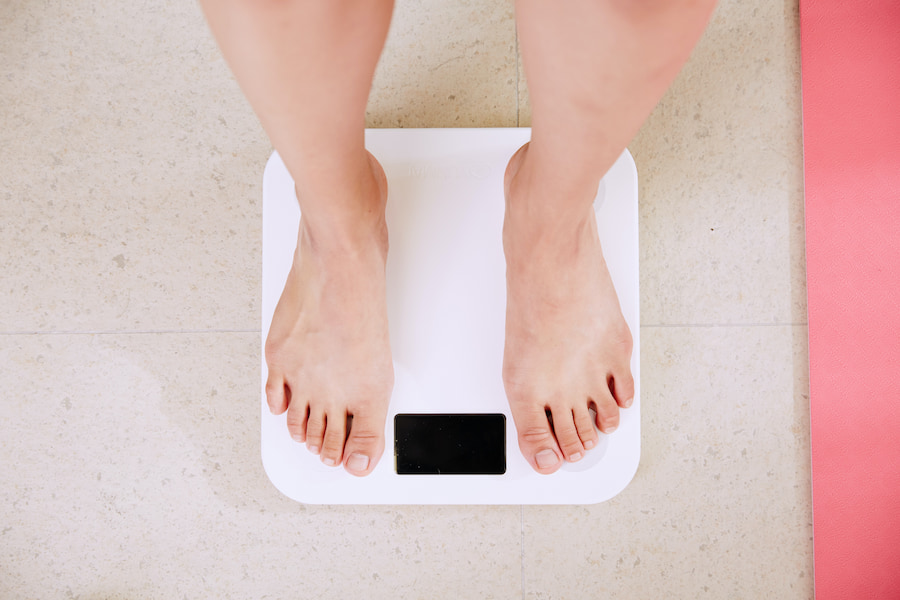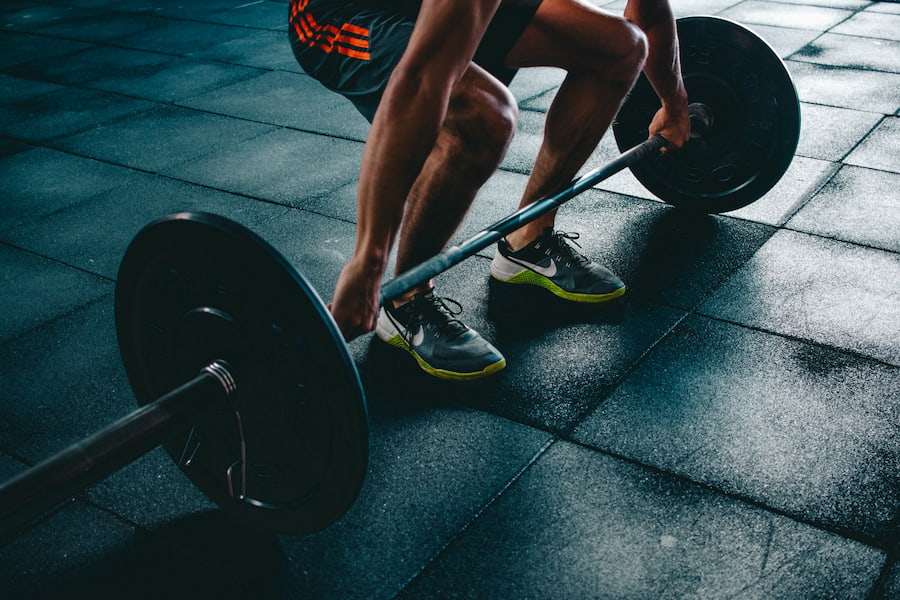
Feeling lost when it comes to body composition? You aren’t alone. Luckily, a basic understanding of body composition can help you understand how to get into (and stay) in shape.
Keep reading for a beginner’s guide to body composition, including tips for how to calculate body composition and body composition exercises.
What is Body Composition?
Body composition, as the term implies, is a measurement of what the body is composed of. There are many ways to measure body composition, and each of them give an estimation of the main tissues and organs that contribute to body mass, including:
- Fat-free tissue (lean body mass, such as muscle and bone)
- Fat tissue (adipose)
- Extracellular water (water located in the body but outside the cells)
Some measures of body composition are simple. For example, technically a common bathroom scale can give you a rough idea of body composition. If you’re a relatively healthy person who works out and you see your weight going up, you may guess that you’re gaining muscle instead of fat. Other methods of measuring body composition, like a whole body scan, are a little more complicated but will provide you with more exact percentages (and a lot more clues about your health).
Many measures of body composition can also tell you where body mass is distributed. People find this particularly helpful for identifying the tissues or organs where excess fat has accumulated. For example, a body composition test may be able to tell you if fat tends to accumulate around your abdomen.
Ways to Measure Body Composition
A body composition test may sound intimidating, but most methods for measuring body composition are non-invasive. This means they won’t harm you in any way and aren’t designed to enter the body. Usually, they cause minor (if any) discomfort or inconvenience, and can provide you with plenty of helpful information.
More Advanced Imaging
While magnetic resonance imaging (MRI) and computerized tomography (CT) scans are considered the “gold standard” when it comes to determining body composition, these tests can often be expensive to administer. Even though whole body versions of these tests can be performed, they are often utilized to look at just one region or organ of the body.
DXA Scans
Alternatively, a form of bone density scanning called dual-energy X-ray absorptiometry (DXA or DEXA) has become a popular way to assess lean body mass. It does this by using low-dose X-rays to measure bone mass and bone mineral density, which can give you and your medical practitioners a better idea of your fall or fracture risk.
So what does DXA have to do with weight? While it’s focused on bone density, a DXA scan is a body composition scan that can also give you clues about fat tissue and lean mass in your body. In other words, although a DXA scan assesses bone, it also gives you an in-depth picture on other components of your body (such as muscle and fat).
Often, athletes will utilize DXA scans to better understand their muscle mass and the amount of overall fat percentage they have. Luckily, you don’t have to be an athlete to take advantage of this test. While you might have to ask your medical provider for more information, the scan can be used for everyone.
Underwater Weighing
Another popular method for determining body composition among athletes is called hydrostatic underwater weighing. While it involves some complicated science, the idea behind this method is quite simple. It measures how much water is displaced once a person submerges themselves in a special kind of tank.
This type of test is usually done by a qualified medical professional. They take measurements before and after the test, as well as make the necessary calculations. While it is a little more involved than other types of testing, it’s been considered a “gold standard” by some scientists for measuring the ratio of body fat to lean mass.
Ultrasounds and Skinfold Tests
If your doctor wants a clue to your body composition, they may use an ultrasound machine in-office on the day of your appointment. An ultrasound provides a basic picture of the amount of fat surrounding an organ, skin, or muscle. It can also detect more serious growths or scarring.
Alternatively, a tool called a skinfold caliper may be used. This is another tool often employed with athletes, and it estimates total body fat by measuring a smaller area of pinched skin. That may sound painful, but it’s actually harmless and takes just a few minutes for your doctor or dietitian to do.

Personal Scales & Calculators
Not feeling like a trip to the doctor’s office? Personal body composition scales and body composition calculators may be a good fit for you.
While they aren’t considered the most accurate, at-home scales and tools can make measuring your body composition more accessible. They can give you a rough estimate of where you are in relation to your goals. These devices can be inexpensive, however the higher-quality a device is, the more accurate it may be.
Thanks to technology, measuring your body composition is easier than ever before. In fact, the University of North Carolina (UNC) has an online body composition calculator. You’ll want to read the instructions and make sure you’re included within the populations it’s proven to be more accurate for.
Which Method is Best?
Some tests are more accurate than others. For example, a doctor- or dietitian-administered DXA body scan will likely give you more accurate information than an at-home scale and calculator app combo. However, most any method can give you useful information and help keep you motivated to make meaningful changes.
It’s worth noting that the possibility of error exists with any method of measuring body composition. In other words, no method is 100% accurate. Measures of body composition are generally designed to empower you with more personalized information. That way, you can decide the next steps in your health journey.
What is the Ideal Body Composition?
The “ideal” body composition completely depends on you and your goals! Maybe you’re an athlete looking to stay under a certain body fat percentage. Maybe you’re just someone who loves working out and wants clues to better understand your own body.
In any case, working with a professional to assess your body composition can help. If you’re worried about specific conditions or ranges, it may be best to meet with your doctor and ask about measuring body composition. If you’re in relatively good health and are just curious, using an at-home body composition scale or app can be a casual way to access the information.
Other than having healthy bones, people are often most concerned with the amount of fat they’re carrying around on their bodies. While “ideal” ranges may vary from person to person, the following provide a general goal for body fat percentage and can help you decide your own body composition goals:
- Essential
- Men: 2-5%
- Women: 10-13%
- Acceptable
- Men: 18-24%
- Women: 25-31%
- Athletes
- Men: 6-13%
- Women: 14-20%
Keep in mind that certain life stages may affect your body composition. For example, pregnancy or aging may affect fat distribution or the amount of water you retain. It’s important to remember that during these seasons of life, it’s important to aim for “healthy” instead of an unrealistic “ideal” body type. In fact, adding a little extra weight as you age may even provide certain health benefits.

Can Kratom Improve Composition?
To be completely honest, we are still waiting on the science as it relates to kratom and body composition. However, kratom has proven popular among the bodybuilder community.
Kratom gummies and gel pouches are popular among our customers living a more active lifestyle, since they can be taken on-the-go. Learn more about kratom and exercise by reading Kratom and Your Workout: 2023 Edition and Ways to Maximize Your Fitness Goals in 2023.
The Bottom Line on Body Composition
There’s no “right” way to measure body composition, just the way that works best for you. If you’re an athlete or especially health-conscious, you may want to work with a professional to assess exact percentages and to make a plan for altering your composition accordingly. If you have a casual interest, you may want to try at-home methods and keep up the healthy habits you have already worked into your workout routine.
References
Borga M, West J, Bell JD, Harvey NC, Romu T, et al. Advanced body composition assessment: from body mass index to body composition profiling. J Investig Med. 2018;66(5).
Cleveland Clinic. DEXA (DXA) Scan: Bone Density Test. My.clevelandclinic.org. Published December 2020.
Corleone J. Body Composition: What It Is and Why It Matters. Verywellfit.com. Published November 2022.
Gallagher D, Chung S, Akram M. Body Composition. In:Encyclopedia of Human Nutrition (Third Edition). Elsevier. 2013:191-199.
Müller MJ, Geisler C, Bosy-Westphal. Body Composition. In: Encyclopedia of Endocrine Disease (Second Edition). Elsevier. 2019;1:406-413.
NHS. How it is performed – Bone density scan (DEXA scan). Nhs.uk. Published October 2022.
O’Dwyer V, Hogan J, Farah N, et al. Changes in maternal body composition during pregnancy. ADC Fetal Neonatal. 2012;97:A47.
Quinn E. How to Measure Body Fat With Hydrostatic Underwater Weighing. Verywellfit.com. Published October 2022.
UC Davis Health. DXA body composition analysis. Health.ucdavis.edu. Accessed May 2023.
Weight Management Clinic. Body Composition Analysis. Romeroweightmanagement.com. Accessed May 2023.



